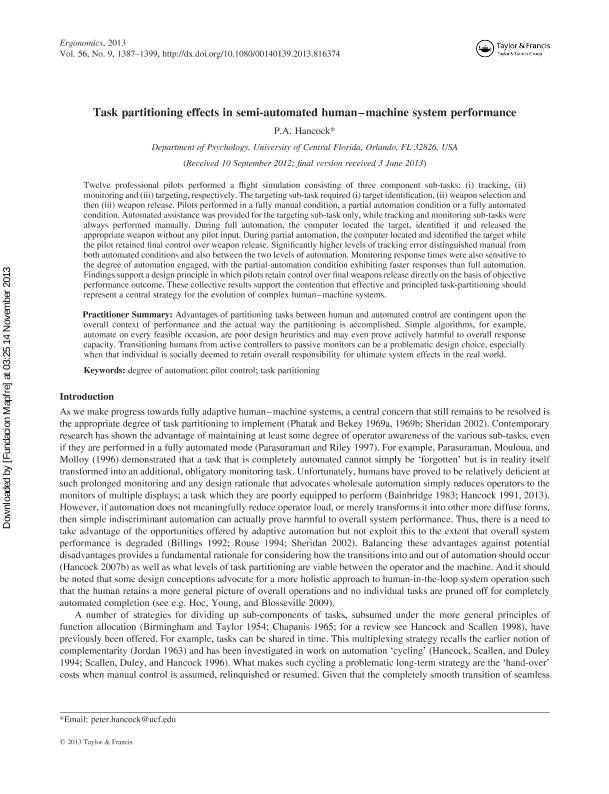Task partitioning effects in semi-automated human-machine system performance

Contenido multimedia no disponible por derechos de autor o por acceso restringido. Contacte con la institución para más información.
| Tag | 1 | 2 | Value |
|---|---|---|---|
| LDR | 00000cab a2200000 4500 | ||
| 001 | MAP20130037646 | ||
| 003 | MAP | ||
| 005 | 20131118120130.0 | ||
| 008 | 131114e20130902esp|||p |0|||b|spa d | ||
| 040 | $aMAP$bspa$dMAP | ||
| 084 | $a875 | ||
| 100 | 1 | $0MAPA20080071066$aHancock, P.A. | |
| 245 | 1 | 0 | $aTask partitioning effects in semi-automated human-machine system performance$cP.A. Hancock |
| 520 | $aTwelve professional pilots performed a flight simulation consisting of three component sub-tasks: (i) tracking, (ii) monitoring and (iii) targeting, respectively. The targeting sub-task required (i) target identification, (ii) weapon selection and then (iii) weapon release. Pilots performed in a fully manual condition, a partial automation condition or a fully automated condition. Automated assistance was provided for the targeting sub-task only, while tracking and monitoring sub-tasks were always performed manually. During full automation, the computer located the target, identified it and released the appropriate weapon without any pilot input. During partial automation, the computer located and identified the target while the pilot retained final control over weapon release. Significantly higher levels of tracking error distinguished manual from both automated conditions and also between the two levels of automation. Monitoring response times were also sensitive to the degree of automation engaged, with the partial-automation condition exhibiting faster responses than full automation. Findings support a design principle in which pilots retain control over final weapons release directly on the basis of objective performance outcome. These collective results support the contention that effective and principled task-partitioning should represent a central strategy for the evolution of complex humanmachine systems. | ||
| 773 | 0 | $wMAP20100019818$tErgonomics : the international journal of research and practice in human factors and ergonomics$dOxon [United Kingdom] : Taylor & Francis, 2010-$x0014-0139$g02/09/2013 Volumen 56 Número 9 - septiembre 2013 |

